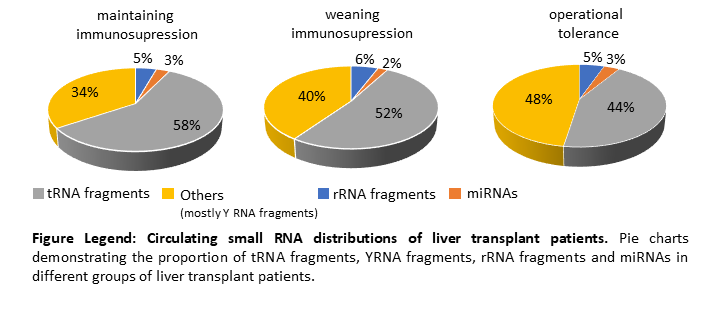Tolerant Liver Transplant Patients Have Higher Level of Y RNA Fragments in the Circulation
1Transplant Research Institute, James D. Eason Transplant Institute, Department of Surgery, University of Tennessee Health Science Center, Memphis, TN, 2James D. Eason Transplant Institute, Department of Surgery, University of Tennessee Health Science Center, Memphis, TN, 3Thomas E. Starzl Transplantation Institute, Children's Hospital of Pittsburgh, University of Pittsburgh Medical Center, Pittsburgh, PA
Meeting: 2020 American Transplant Congress
Abstract number: D-380
Keywords: Genomic markers, Immunosuppression, Liver, Tolerance
Session Information
Session Name: Poster Session D: Tolerance / Immune Deviation
Session Type: Poster Session
Date: Saturday, May 30, 2020
Session Time: 3:15pm-4:00pm
 Presentation Time: 3:30pm-4:00pm
Presentation Time: 3:30pm-4:00pm
Location: Virtual
*Purpose: Tolerance post transplantation continue to be the ultimate goal in transplantation. Circulating small RNAs are one of the best candidates for biomarker studies. To identify signatures of tolerance, we examined small RNA (sRNA) profile in plasma of liver transplant patients using sRNA-seq.
*Methods: Our cross-sectional study cohort consisted of 55 pediatric LT recipients with stable long-term liver function who were free of infections and autoimmunity: Maintenance immunosuppression (MI, n=12) group on tacrolimus, weaning immunosuppression (WI, n=26) group on monitored tacrolimus withdrawal, and operational tolerance (OT, n=17) group off all immunosuppression. We isolated sRNAs from all plasma samples. sRNA libraries were generated and sequenced using Next Generation Sequencing. We used the online tool that has been generated by exRNA consortium to analyze the data.
*Results: Different groups of sRNAs including miRNAs, Y RNA fragments and rRNA fragments in the plasma RNA were detected in all sub-groups. While a small number of miRNAs were identified, tRNA and Y RNA fragments were the most abundant species in all groups. Interestingly, the proportion of tRNA fragments was decreased in OT (58% in MI, 52% in WI and 44% in OT) whereas proportion of Y RNA fragments was increased (34% in MI, 40% in WI and 48% in OT) [Figure]. In addition, distribution of sRNA species in healthy subjects was similar to that observed in OT group. Y RNAs interact with Ro60 protein and bind to TLR7 to activate immune response in autoimmune diseases. Then, likely tolerant patients may degrade/process YRNAs to YRNA fragments which results in the higher levels of circulating Y RNA fragments and lower levels of immune activity.
*Conclusions: Our results suggest that proportion of tRNA fragments and Y RNA fragments in plasma small RNA population are potential candidates for understanding operational tolerance in patients. Additional sequence characterization and identification of YRNA fragments with prospective analyses will yield novel insights into mechanisms underlying transplant tolerance in patients.
To cite this abstract in AMA style:
Kuscu C, Wolen A, Bajwa A, Kuscu C, Eason J, Ramaswami B, Maluf D, Mazariegos G, Chalasani G, Mas V. Tolerant Liver Transplant Patients Have Higher Level of Y RNA Fragments in the Circulation [abstract]. Am J Transplant. 2020; 20 (suppl 3). https://atcmeetingabstracts.com/abstract/tolerant-liver-transplant-patients-have-higher-level-of-y-rna-fragments-in-the-circulation/. Accessed December 18, 2025.« Back to 2020 American Transplant Congress

